Breast Density and Your Mammogram Report
Regular mammograms are the best way to find breast cancer early. But if your mammogram report says you have dense breast tissue, you might be wondering what that means for you.
- What is dense breast tissue?
- How do I know if I have dense breasts?
- Do mammogram reports have to include breast density?
- Understanding breast density in your mammogram report
- Why is breast density important?
- If I have dense breasts, do I still need a mammogram?
- Should I have any other screening tests if I have dense breast tissue?
- What should I do if I have dense breast tissue?
What is dense breast tissue?
Breast density is a measure of how much fibrous and glandular tissue (also known as fibroglandular tissue) there is in your breast, as compared to fat tissue. It isn’t related to breast size or firmness.
Breasts are made up of lobules, ducts, and fatty and fibrous connective tissue.
- Lobules are the small glands that produce milk, while ducts are the tiny tubes that carry the milk from the lobules to the nipple. Together, the lobules and ducts are referred to as glandular tissue.
- Fibrous tissue and fat give breasts their size and shape and hold the other structures in place.
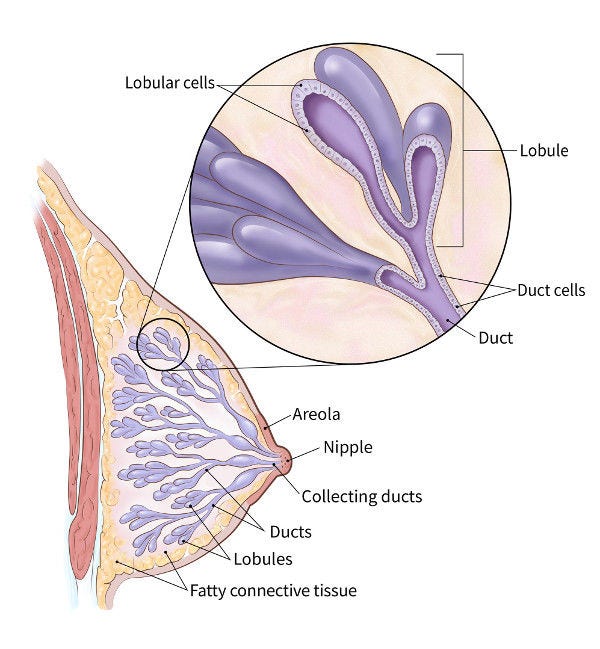
Fibrous and glandular tissue are harder to see through on a mammogram, so your breast tissue may be called ‘dense’ if you have a lot of these tissues (and not as much fat).
Having dense breast tissue is common. Some women have more dense breast tissue than others. For most women, breasts become less dense with age. But in some women, there’s little change.
How do I know if I have dense breasts?
Radiologists are doctors who “read” mammograms (and other types of imaging tests). They check your mammogram for abnormal areas, and they also look at breast density.
There are 4 categories of breast density. They go from almost all fatty tissue to extremely dense tissue with very little fat. The radiologist looks at your mammograms to determine which of the 4 categories best describes how dense your breasts are:
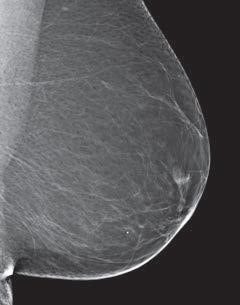
Category A: Breasts are almost all fatty tissue.
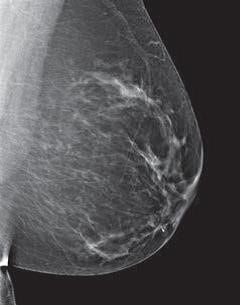
Category B: There are scattered areas of dense glandular and fibrous tissue (seen as white areas on the mammogram).
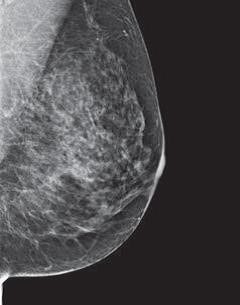
Category C: More of the breast is made of dense glandular and fibrous tissue (described as heterogeneously dense). This can make it hard to see small masses in or around the dense tissue, which also appear as white areas.
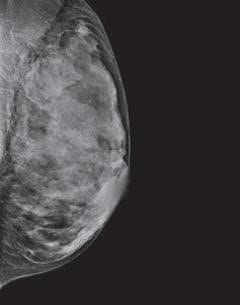
Category D: Breasts are extremely dense, which makes it harder to see masses or other findings that may appear as white areas on the mammogram.
In general, patients whose breast density falls into categories C (heterogeneously dense) or D (extremely dense) are considered to have dense breast tissue. This includes about half of all women in the US who have mammograms to look for breast cancer.
Mammogram reports sent to health care providers typically include a description of breast density, so your health care provider can tell you if your mammogram shows that you have dense breasts. Mammogram reports sent directly to patients often mention breast density as well, although the wording used in these reports is often different (see below).
Do mammogram reports have to include breast density?
As of September 10, 2024, the Food and Drug Administration (FDA) requires that all mammogram reports sent to patients must include breast density, which should be described as either “not dense” or “dense.”
If your breast tissue is not dense, the report will say, “Breast tissue can be either dense or not dense. Dense tissue makes it harder to find breast cancer on a mammogram and also raises the risk of developing breast cancer. Your breast tissue is not dense. Talk to your healthcare provider about breast density, risks for breast cancer, and your individual situation.”
If your breast tissue is dense, the report will say, “Breast tissue can be either dense or not dense. Dense tissue makes it harder to find breast cancer on a mammogram and also raises the risk of developing breast cancer. Your breast tissue is dense. In some people with dense tissue, other imaging tests in addition to a mammogram may help find cancers. Talk to your healthcare provider about breast density, risks for breast cancer, and your individual situation.”
In addition, mammogram reports sent to healthcare providers must include an overall assessment of breast density using the 4 categories described above.
Understanding breast density in your mammogram report
Why is breast density important?
Breast density is important for two main reasons:
- Women who have dense breast tissue have a higher risk of breast cancer compared to women with less dense breast tissue. It’s unclear at this time why dense breast tissue is linked to breast cancer risk. It may be that dense breast tissue has more cells that can develop into abnormal cells.
- Dense breast tissue also makes it harder for radiologists to see cancer on mammograms. Dense (fibrous and glandular) breast tissue looks white on a mammogram. Breast masses and cancers can also look white, so the dense tissue can make it harder to see them. In contrast, fatty tissue looks almost black on a mammogram, so it’s easier to see a tumor that looks white if most of the breast is fat tissue.
If I have dense breasts, do I still need a mammogram?
Yes. Most breast cancers can be seen on a mammogram even in women who have dense breast tissue, so it’s still important to get regular mammograms. Mammograms can help save women’s lives.
Even if you have a normal mammogram report, you should know how your breasts normally look and feel. Anytime there’s a change, you should report it to a health care provider right away.
Should I have any other screening tests if I have dense breast tissue?
At this time, experts do not agree what other tests, if any, should be done in addition to mammograms in women with dense breasts.
Digital breast tomosynthesis (3D mammography) can find some cancers not seen on regular (2D) mammograms. Some studies have suggested 3D mammography might be particularly helpful in women with dense breasts. It can be used as a screening test along with or instead of standard mammography, although it isn’t yet available at all imaging centers.
Studies have shown that breast ultrasound and possibly magnetic resonance imaging (MRI) can also help find some breast cancers that can’t be seen on mammograms. But ultrasound and MRI can also show more findings that are not cancer. This can lead to more tests and unnecessary biopsies. And the cost of an ultrasound or MRI may not be covered by insurance.
Talk to your health care provider about whether you should consider any of these tests.
What should I do if I have dense breast tissue?
If your mammogram report says that you have dense breast tissue, talk with your health care provider about what this means for you. Be sure that your doctor or nurse knows if there’s anything in your medical history that increases your risk for breast cancer. To learn more about breast cancer risk factors, see Breast Cancer Risk and Prevention.
Any woman who’s already in a high-risk group (based on inherited gene mutations, a strong family history of breast cancer, or other factors) should have an MRI along with her yearly mammogram. To learn more about if you’re in a higher-risk group for breast cancer, see American Cancer Society Recommendations for the Early Detection of Breast Cancer.
- Written by
- References

The American Cancer Society medical and editorial content team
Our team is made up of doctors and oncology certified nurses with deep knowledge of cancer care as well as editors and translators with extensive experience in medical writing.
American College of Radiology. BI-RADS ATLAS – Mammography. Reporting System, 2013. Accessed at https://www.acr.org/-/media/ACR/Files/RADS/BI-RADS/Mammography-Reporting.pdf on October 1, 2021.
Food and Drug Administration. Mammography Quality Standards Act: Final rule. Federal Register. March 10, 2023. 88(47):15126-15171. Accessed at https://www.govinfo.gov/content/pkg/FR-2023-03-10/pdf/2023-04550.pdf on March 27, 2023.
Freer PE, Slanetz PJ. Breast density and screening for breast cancer. UpToDate. 2023. Accessed at https://www.uptodate.com/contents/breast-density-and-screening-for-breast-cancer on March 28, 2023.
Helvie MA, Patterson SK. Chapter 11: Imaging Analysis: Mammography. In: Harris JR, Lippman ME, Morrow M, Osborne CK, eds. Diseases of the Breast. 5th ed. Philadelphia, Pa: Lippincott Williams & Wilkins; 2014.
Kerlikowske K, Ichikawa L, Miglioretti DL, et al. Longitudinal measurement of clinical mammographic breast density to improve estimation of breast cancer risk. J Natl Cancer Inst. 2007;99(5):386-395.
Lee CI, Chen LE, Elmore JG. Risk-based breast cancer screening - Implications of breast density. Medical Clinics of North America. 2017;101(4):725-741.
Melnikow J, Fenton JJ, Whitlock EP, et al. Supplemental screening for breast cancer in women with dense breasts: A systematic review for the US Preventive Services Task Force. Ann Intern Med. 2016;164(4):268-278.
Saslow D, Boetes C, Burke W, et al. American Cancer Society guidelines for breast screening with MRI as an adjunct to mammography. CA Cancer J Clin. 2007 Mar-Apr;57(2):75-89.
Venkataraman S, Slanetz PJ, Lee CI. Breast imaging for cancer screening: Mammography and ultrasonography. UpToDate. 2021. Accessed at https://www.uptodate.com/contents/breast-imaging-for-cancer-screening-mammography-and-ultrasonography on October 1, 2021.
Last Revised: September 9, 2024
American Cancer Society medical information is copyrighted material. For reprint requests, please see our Content Usage Policy.
American Cancer Society Emails
Sign up to stay up-to-date with news, valuable information, and ways to get involved with the American Cancer Society.


